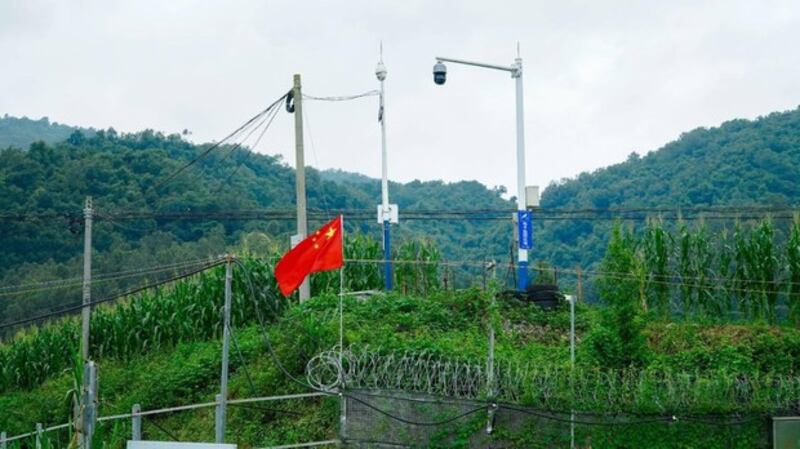Villagers living along Myanmar’s mountainous border with China are destroying fences put up by Chinese authorities to block travelers who might spread COVID-19, saying the barriers have been built inside Myanmar territory, sources say.
The destruction of fencing in northern Myanmar’s Kachin state and Shan state in the country’s east is causing friction along the border, with both residents and politicians faulting the two countries for letting the problem fester.
China’s embassy in Myanmar denied any Chinese encroachment and called the construction of fences “a common practice in many countries to strengthen border management.”
On Oct. 25, residents of Pangkham village in Shan state’s Muse township took down a fence they said had been set up nearly 30 feet inside village land, one villager said, speaking on condition of anonymity.
Villagers first saw the new fence when they went to their fields to plant crops, he said.
“China had first built a solid fence in 2014, but after that they set up barbed wire that was put from 20 to 30 feet inside our own land, and we removed this new fence,” he said, adding that when villagers had previously gone to work in their fields, Chinese soldiers had appeared there to make a show of force.
“And so we villagers have been moved back four times already,” he said.
China has not yet responded to the removal of this newest fence, villagers said.
Muse, the main border crossing into China, lies across a river from Ruili (Shweli, in Burmese) in southwestern China's Yunnan Province.
This is the third such dispute between Chinese border authorities and residents of the Muse district in the last two months, villagers said.
The Muse township administrator and other local officials have now visited Pangkham, an area close to Chinese border town of Jiagou, and say they will file a report on the situation with higher-ups at the district level, they said.
In another incident on Sept. 12, residents of Namkham township’s Hak Hin village took down a Chinese fence extending into village land after Chinese authorities rebuffed villagers’ objections, village chief Lon Ai Suan said.
Since the outbreak of the first wave of the coronavirus pandemic in China in April 2020, border crossings have been tightened on the Chinese side of the border with Myanmar to control the entry and exit of Myanmar nationals, resulting in frequent disputes, sources say.
'Can't do anything on our own'
Authorities in both countries have been unable so far to settle the issue of encroachment, said Sai Hla Pe, chairman of the Shan Nationalities League for Democracy (SNLD) in northern Shan state, pointing to frequent incidents in Pansai, Pangkham, and the Naung Mon areas of Muse.
“We have gone to these places to see for ourselves,” he said.
“The problem should be solved between the two governments, because we can’t do anything about this on our own. We can only report to the authorities on the results of our investigations in the field,” he said.
Charges of encroachment by China have also been made by villagers in Kachin state, where one resident said a 20-foot-tall, 500-foot-long fence was put up between Waingmaw and Kanpaiti townships during the last week of July.
“It’s obvious that they are doing whatever they want in the uninhabited areas of Myanmar,” Zay Jones, a resident of Kanpaiti, said. “They are expanding into our country, and no one says anything about it,” he said.
“You can see barbed wire fences on the mountains from Kanpaiti. No one knows for sure whether these mountains are in Myanmar or in China, but we know [the fences] are on the Myanmar side.”
“The Chinese just put up fences wherever they want,” he said.
Local residents said that Kanpaiti township officials have sent a letter of protest to Chinese officials on the other side, but that no replies have been received.
Local officials in Shan state’s Muse district conduct field inspections and “send objections to the relevant Chinese departments when problems occur," an official from the district's administration department said, also speaking on condition of anonymity.
"And if there is a violation of an agreement we signed earlier, we will send a letter of protest and report the situation to higher authorities,” the official said.
“In some places where we have found a definite encroachment, they have had to pull it down, and in other places we have had to consult with joint inspection teams from both sides. But because of COVID, this isn’t happening at present,” he said.

'China may have reached an understanding'
In Kachin state, the Chinese border lies mostly along areas controlled by the ethnic Kachin Independence Army (KIA), and almost all of it has been fenced off by China, local sources said. China has been building new fences since July near the remote mountain town of Laiza and in other places, they added.
China may be prioritizing the building of fences in these areas to stop refugees entering China because of concerns over the political situation in Myanmar nine months after a Feb. 1 military coup overthrew the country’s elected civilian government, sparking widespread protests and fighting.
“China may have reached an understanding with the ethnic armed groups,” said Than Soe Naing, an analyst of ethnic affairs in Myanmar.
“Thus, we see today that new fences are being set up, especially in areas where there are clashes between junta forces and local militias who are trying to stop [central government] incursions into their land,” he said.
Attempts to reach Myanmar’s Ministry of Foreign Affairs for comment were unsuccessful.
China’s embassy in Myanmar in an email to RFA’s Myanmar Service on Monday called the construction of border fences “a common practice in many countries to strengthen border management.”
“The fences will not enter Myanmar territory,” the embassy said.
“China and Myanmar have been in close communication on this issue and hope the media can report it objectively.”
Reported by RFA’s Myanmar Service. Translated by Khin Maung Nyane. Written in English by Richard Finney.
